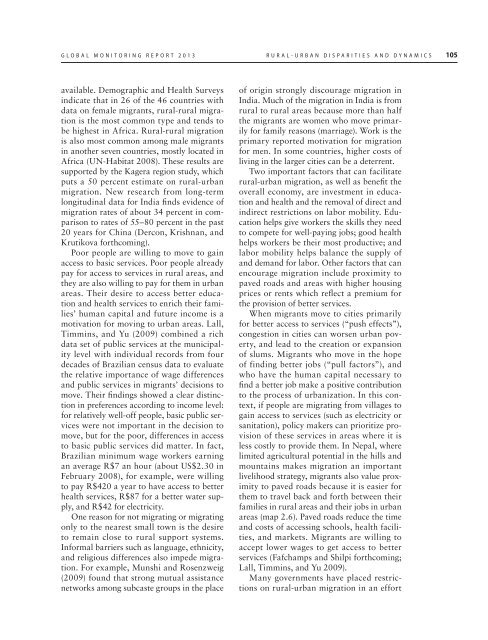rural-urban dynamics_report.pdf - Khazar University
rural-urban dynamics_report.pdf - Khazar University
rural-urban dynamics_report.pdf - Khazar University
Create successful ePaper yourself
Turn your PDF publications into a flip-book with our unique Google optimized e-Paper software.
GLOBAL MONITORING REPORT 2013 RURAL-URBAN DISPARITIES AND DYNAMICS 105<br />
available. Demographic and Health Surveys<br />
indicate that in 26 of the 46 countries with<br />
data on female migrants, <strong>rural</strong>-<strong>rural</strong> migration<br />
is the most common type and tends to<br />
be highest in Africa. Rural-<strong>rural</strong> migration<br />
is also most common among male migrants<br />
in another seven countries, mostly located in<br />
Africa (UN-Habitat 2008). These results are<br />
supported by the Kagera region study, which<br />
puts a 50 percent estimate on <strong>rural</strong>-<strong>urban</strong><br />
migration. New research from long-term<br />
longitudinal data for India finds evidence of<br />
migration rates of about 34 percent in comparison<br />
to rates of 55–80 percent in the past<br />
20 years for China (Dercon, Krishnan, and<br />
Krutikova forthcoming).<br />
Poor people are willing to move to gain<br />
access to basic services. Poor people already<br />
pay for access to services in <strong>rural</strong> areas, and<br />
they are also willing to pay for them in <strong>urban</strong><br />
areas. Their desire to access better education<br />
and health services to enrich their families’<br />
human capital and future income is a<br />
motivation for moving to <strong>urban</strong> areas. Lall,<br />
Timmins, and Yu (2009) combined a rich<br />
data set of public services at the municipality<br />
level with individual records from four<br />
decades of Brazilian census data to evaluate<br />
the relative importance of wage differences<br />
and public services in migrants’ decisions to<br />
move. Their findings showed a clear distinction<br />
in preferences according to income level:<br />
for relatively well-off people, basic public services<br />
were not important in the decision to<br />
move, but for the poor, differences in access<br />
to basic public services did matter. In fact,<br />
Brazilian minimum wage workers earning<br />
an average R$7 an hour (about US$2.30 in<br />
February 2008), for example, were willing<br />
to pay R$420 a year to have access to better<br />
health services, R$87 for a better water supply,<br />
and R$42 for electricity.<br />
One reason for not migrating or migrating<br />
only to the nearest small town is the desire<br />
to remain close to <strong>rural</strong> support systems.<br />
Informal barriers such as language, ethnicity,<br />
and religious differences also impede migration.<br />
For example, Munshi and Rosenzweig<br />
(2009) found that strong mutual assistance<br />
networks among subcaste groups in the place<br />
of origin strongly discourage migration in<br />
India. Much of the migration in India is from<br />
<strong>rural</strong> to <strong>rural</strong> areas because more than half<br />
the migrants are women who move primarily<br />
for family reasons (marriage). Work is the<br />
primary <strong>report</strong>ed motivation for migration<br />
for men. In some countries, higher costs of<br />
living in the larger cities can be a deterrent.<br />
Two important factors that can facilitate<br />
<strong>rural</strong>-<strong>urban</strong> migration, as well as benefit the<br />
overall economy, are investment in education<br />
and health and the removal of direct and<br />
indirect restrictions on labor mobility. Education<br />
helps give workers the skills they need<br />
to compete for well-paying jobs; good health<br />
helps workers be their most productive; and<br />
labor mobility helps balance the supply of<br />
and demand for labor. Other factors that can<br />
encourage migration include proximity to<br />
paved roads and areas with higher housing<br />
prices or rents which reflect a premium for<br />
the provision of better services.<br />
When migrants move to cities primarily<br />
for better access to services (“push effects”),<br />
congestion in cities can worsen <strong>urban</strong> poverty,<br />
and lead to the creation or expansion<br />
of slums. Migrants who move in the hope<br />
of finding better jobs (“pull factors”), and<br />
who have the human capital necessary to<br />
find a better job make a positive contribution<br />
to the process of <strong>urban</strong>ization. In this context,<br />
if people are migrating from villages to<br />
gain access to services (such as electricity or<br />
sanitation), policy makers can prioritize provision<br />
of these services in areas where it is<br />
less costly to provide them. In Nepal, where<br />
limited agricultural potential in the hills and<br />
mountains makes migration an important<br />
livelihood strategy, migrants also value proximity<br />
to paved roads because it is easier for<br />
them to travel back and forth between their<br />
families in <strong>rural</strong> areas and their jobs in <strong>urban</strong><br />
areas (map 2.6). Paved roads reduce the time<br />
and costs of accessing schools, health facilities,<br />
and markets. Migrants are willing to<br />
accept lower wages to get access to better<br />
services (Fafchamps and Shilpi forthcoming;<br />
Lall, Timmins, and Yu 2009).<br />
Many governments have placed restrictions<br />
on <strong>rural</strong>-<strong>urban</strong> migration in an effort

















